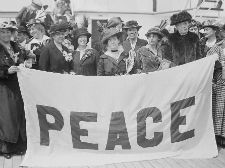WW1 Projects
These Dangerous Women
On 11, Dec 2015 | In WW1 Projects | By Nicola Gauld
These Dangerous Women was an HLF funded project about the women who tried to stop World War 1.
We made a documentary, booklet and exhibition which toured UK in time to mark the centenary of the Women’s Congress at the Hague. I was the documentary director and project manager and I decided to make the film as cinematic as possible so spent a lot of time finding the locations where events took place in 1915. I also decided the best people to portray the 1915 Peace activists and feminists were today’s peace activists and feminists – members of the Women’s International League for Peace and Freedom (WILPF).
WILPF researchers Helen Kay and Katrina Gas had already done a lot of research into the women who became founder members of the organisation and they structured the research which was then carried out by volunteers recruited for the project. Research sessions went ahead with the help and guidance of Anna Towlson at LSE. The training and support from Helen and Katrina meant the volunteers were confident in finding out about these pioneering women and then becoming them for the documentary. They wrote up their findings in the booklet, with each woman writing about one 1915 feminist. Costumiere Lindsey Holmes helped us to find the costumes using a mixture of second hand clothes and hired hats.
Part way through the project academic Alison Ronan got in touch. She had just published a book called ‘A Small Vital Flame’: Anti-war women in the North West 1914-1918. She came to visit the WILPF office in London and told us about her research into women from the North-West of England who were anti-war. These women were Co-operative organisers and factory workers as well as middle class suffragists campaigning for the vote. I realised immediately that her research would give the story much more depth, showing that anti-war women came from all over Britain and from all classes. Alison was very helpful and organised women in Manchester to re-enact the scenes where women became delegates to the Hague Conference. We managed to film scenes in the original building of Milton Hall on Deansgate, and then filmed the women setting off by steam engine to London. Alison was able to interject her research into the documentary by becoming part of the process. She was in costume as one of the activists and was able to set the scene with accurate information as to time and place. She also provided the other women with descriptions of their characters so they were able to portray them with confidence. Alison also corrected misunderstandings telling us that people used formal address in 1915 even if they knew each other well, for example, Miss Ashton, Miss Reddish, Miss Royden.
Helen Kay and Katrina Gas provided the bedrock of research, but Alison’s contribution gave another dimension. We were able to show women from all over Britain and from all classes. This made the story far stronger. Alison was very inspiring to work with and we felt there was more to be said about the alliances between women in 1915, so we are working together on a further project which will explore the Women’s Peace Crusades of 1916 and 1917.
Link to film: https://www.youtube.com/watch?v=0a2xYvXwGiw
Charlotte Bill, Clapham Film Unit
You can also read more about the project here



